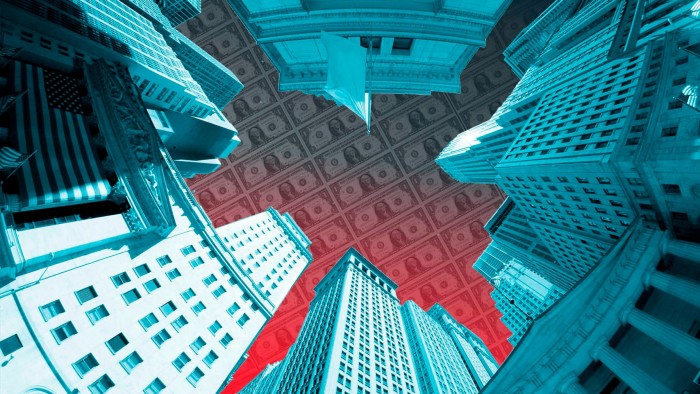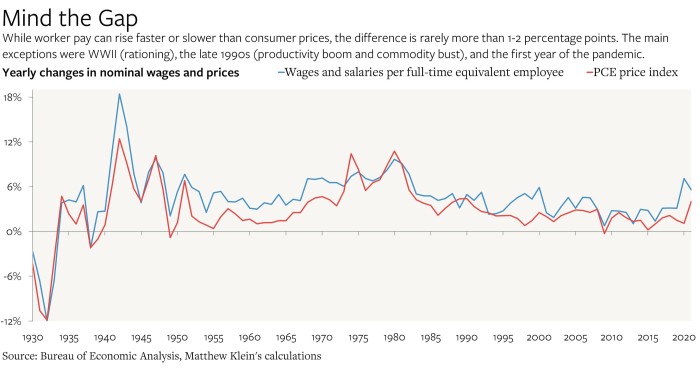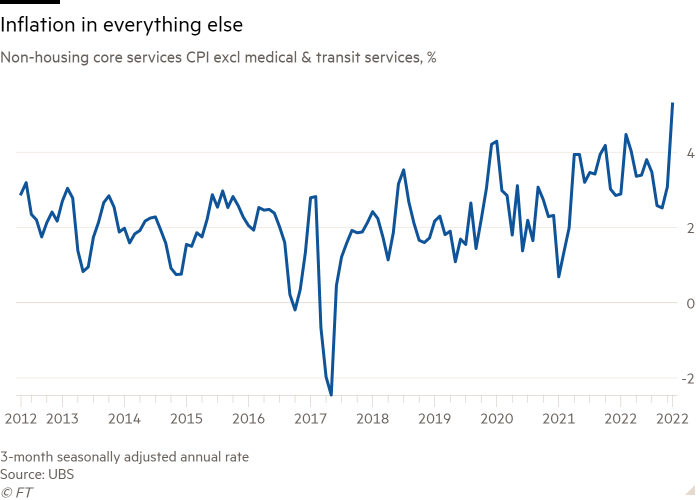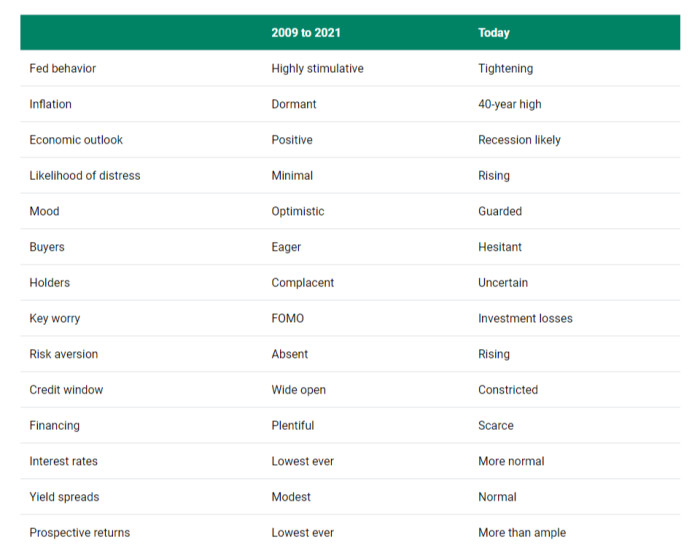The hard kind of inflation


Roula Khalaf, Editor of the FT, selects her favourite stories in this weekly newsletter.
This article is an on-site version of our Unhedged newsletter. Sign up here to get the newsletter sent straight to your inbox every weekday
Good morning. Ugly day for stocks yesterday. We’d say it was the market finally accepting our obviously correct view of inflation and the Federal Reserve’s reaction function, but if that were the case, you’d see bonds moving too. They didn’t. Send us a better theory: robert.armstrong@ft.com and ethan.wu@ft.com.
Those of our readers who, like Rob, are interested in clothes and the business of clothes, should check out Lauren Indvik’s excellent Fashion Matters newsletter. Here’s a sample; and here is the sign-up link.
Three tales of services inflation & wages
Jay Powell thinks inflation is worryingly high in non-housing core services. That clunky phrase captures prices from bus rides to hospital stays and, in Powell’s opinion, holds the key to inflation’s path forward. He believes inflation in this category is driven by wages. The big inflation question, in other words, is whether the Fed can cool the labour market.
A conventional enough view, but it’s worth asking how labour market conditions drive this kind of inflation. We see at least three ways to look at it:
Through business costs. Powell’s stated justification is that “wages make up the largest cost in delivering these services”. This story feels very intuitive. Services, by definition, involve someone serving you, and that person needs to be paid. Fed research often asserts the labour-intensity of services without further explanation (if the Fed has done a more detailed treatment somewhere, send it along!). If this account is right, the central bank must step in to stop a spiral of escalating costs and prices.
Through labour-intensive business costs. A different version of the cost story, which accepts the premise that business costs link wages and inflation, but distinguishes between higher labour-intensity services (think restaurants) and lower-intensity ones (think airfares, heavily influenced by the cost of jet fuel). Strong wage growth lifts inflation but its influence is particular, not general. It’s not a big leap from here to concluding that if inflation in specific wage-sensitive segments are offset by deflation elsewhere, overall inflation looks less menacing.
Through consumption. The argument is that high wage growth sustains above-trend consumer spending. This is keeping demand well above supply, resulting in inflation.
We asked the FT’s Martin Wolf what he thinks and, ever the stalwart macroeconomist, he weighed in favour of 1 and 3. Strong wage growth raises consumption, letting companies pass higher wage costs on to unflinching consumers via price increases — a classic wage-price spiral. Martin nodded to the fact that wage cost pressure is more pronounced in labour-intensive sectors, but maintained that these wage pressures show up everywhere.
Over at The Overshoot, Matt Klein argues persuasively for 3. We quoted his post earlier this month:
Employment income is the largest and most reliable source of financing for consumer spending. Wages can rise 1-3 percentage points faster or slower than consumer prices for a variety of reasons — including but not limited to compositional and definitional differences — but larger gaps between the growth rates of wages and prices basically don’t exist outside of WWII and Korean war rationing, the late 1990s productivity boom, and the first year of the pandemic.
His chart below sums it up. With rare exceptions, wage and price growth track one another:

Lastly, Alan Detmeister, a former Fed researcher now at UBS, made the case to us yesterday that 2 (and a bit of 3) is the best explanation. He points to how modest inflation looks in the long tail of services inflation, in contrast to much hotter inflation in labour-intensive services such as haircuts and laundry.
He shows this by taking Powell’s non-housing core services inflation and stripping out medical and transportation services. Broader services inflation does not look so much hotter than before the pandemic:

The exception, as you can see above, is the last data point: the striking uptick in this week’s November CPI report. But while a few labour-intensive services logged abnormally large price increases in November, so did services without an obvious wage link, such as mobile phone plans. Detmeister suspects a blip. The bottom line:
In this period the highest inflation was in goods initially, then it moved to rents, now you’re seeing a little bit of strength in some of these other services, which could mean we’re starting to see some of that [wage] cost pass-through occur. Or it could just be noise . . .
Is the slowing in goods and rents going to be enough to offset those still-strong inflation numbers in the [labour-intensive parts of] non-rent core services? The most recent two [CPI] reports were clear: it looks like the slowing in goods will be enough.
Detmeister thinks the Fed is hammering the economy much too hard and was too eager to move interest rates into restrictive territory, given inflation that he figures will probably moderate on its own.
We’ve been sympathetic to Klein’s consumption account in the past. But the picture is not simple. Powell needs to better explain what he and the Fed believe about services and wages. The link is not self-evident. (Ethan Wu)
Fin de siècle or just a cycle, revisited (with Howard Marks)
Some months ago Unhedged posed this question:
After this period of acute inflation ends, will we return to something like the pre-pandemic status quo? Or will the pandemic mark the end of a 40-year regime of low inflation which, while it was punctuated by crises, featured long steady stretches of high returns for both bonds and stocks?
This issue remains very much up in the air, as far as Unhedged is concerned. Howard Marks of Oaktree, who has been all over the FT in recent months, has put himself in the “fin de siècle” camp in his latest memo to investors. Marks argues that we may be seeing the third investment sea change of his career. The first two were junk bonds entering investment mainstream, opening the way for the buyout wave and private equity, and Paul Volcker’s successful war on inflation, which ushered in four decades of falling rates.
The low rates era reached its apex in the decade before Covid, with ultra-low rates and quantitative easing sending returns flying — so high, in fact, that it was not clear how much higher they could go. The result was Marks’ “low-return world”.
Now, however, inflation has put an end to all that. Rates have risen and prices have fallen. He sums up the shift in this table:

“These changes may be long-lasting, or they may wear off over time. But in my view, we’re unlikely to quickly see the same optimism and ease that marked the post-GFC period,” he writes. The lack of ease pleases him. High-yield bonds that yielded 5 per cent a year ago yield 8 now, so “they’re likely to deliver equity-like returns, sourced from contractual cash flows on public securities”.
My own gut feeling — it’s really nothing more than that — is that the changes Marks documents in his memo will fade fast. In the next year or two, inflation will succumb, and we’ll be back to the slow-growth, low-inflation, high-valuation world of pre-2020. My argument in its entirety: why wouldn’t this happen?
I asked Marks why the world will be different after inflation subsides. He was characteristically modest about predicting the future (“Oaktree’s investment philosophy doesn’t prohibit having opinions, just acting as if they’re right.”) But he offered up the following thought about the US central bank:
Anything can revert to where it used to be, except I don’t think we are going back to zero on [policy] rates. I think the Fed got trapped at zero for a long time and they regretted it, and they won’t want to go back there again. I don’t think the Fed wants to be on a highly stimulative position on an ongoing basis, they want to be at neutral, which I believe is [currently] defined as 2.5 per cent.
I think [Janet] Yellen was really a dove and wanted growth, and [Jay] Powell is more balanced. To routinely keep rates at zero is like waking up every morning and giving yourself a shot of adrenaline. You can’t live on adrenaline.
I’m not sure I agree with Marks here. Will the Fed emerge from the 2009-22 era less sure that very low rates over long periods is a safe strategy?
Certainly the Fed does not like being squeezed up against the zero lower bound, which leaves it dependent on quantitative eating, a tool it neither understands nor trusts. The hard question (as Unhedged’s friend Ed Al-Hussainy of Columbia Threadneedle emphasises) is whether the Fed really chooses near-zero rates — or is forced into them, instead. In an ageing, unequal, low growth, low productivity world, the natural rate of interest might just be really low, leaving the Fed with little room to manoeuvre.
One good read
Harrison Ford, inexhaustible at 80, just wants to work.
Comments